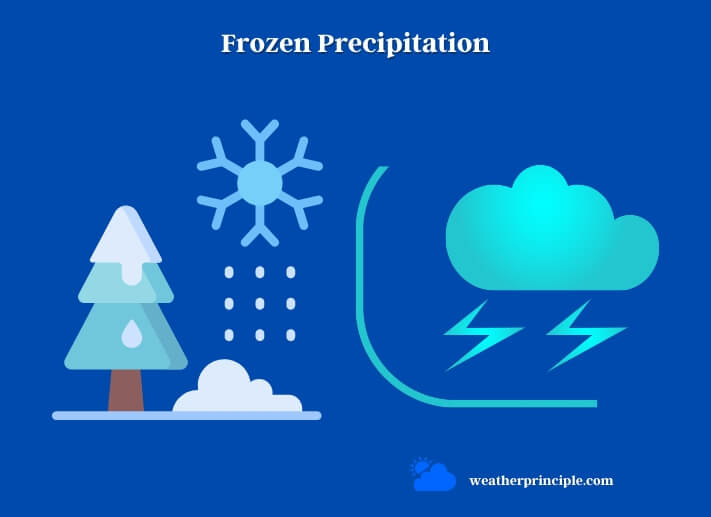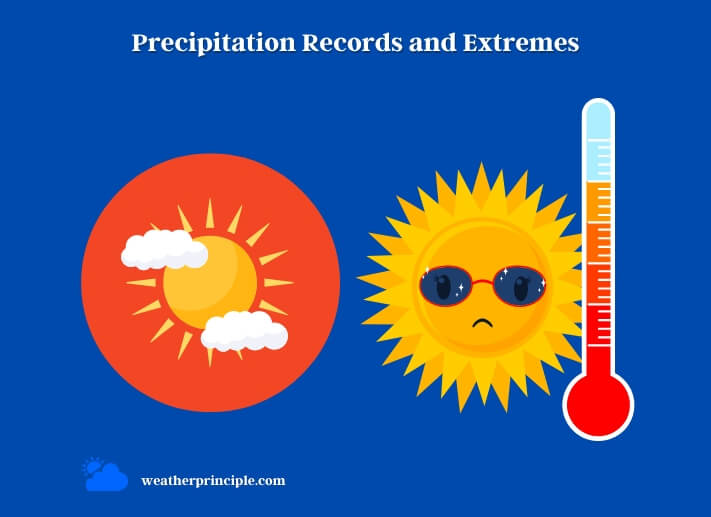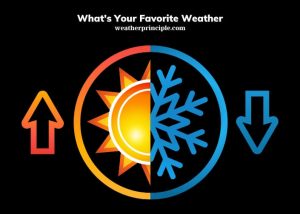Published on: May 13, 2023
Written by Taha Nur / Fact-checked by Kader Khan
Precipitation is a fundamental aspect of our planet’s water cycle and plays a crucial role in supporting life on Earth. It influences our daily lives, from agriculture and water resources to transportation and recreational activities. In this article, we’ll explore the different types of precipitation, the methods used to measure them, and how climate change is impacting precipitation patterns. Let’s dive in and unravel the mysteries behind the marvels of nature.
Liquid Precipitation
Rain
Formation of raindrops
Rain is the most common form of precipitation, originating from the condensation of water vapor in the atmosphere. When air cools, water vapor condenses around microscopic particles, such as dust or pollen, to form cloud droplets. As these droplets collide and coalesce, they grow in size, eventually becoming heavy enough to fall as raindrops.
Drizzle vs. rain
Drizzle is a type of light rain, characterized by small, uniformly dispersed droplets. While rain and drizzle are similar, the key difference lies in the size of the droplets: drizzle droplets are smaller, typically less than 0.5 mm in diameter.

Freezing Rain
Conditions for freezing rain
Freezing rain occurs when raindrops fall through a shallow layer of below-freezing air near the Earth’s surface. As a result, the raindrops freeze upon contact with objects on the ground, forming a thin layer of ice called glaze.
Impact on infrastructure and transportation
Freezing rain can cause hazardous conditions, such as icy roads and walkways, making travel dangerous. It can also lead to power outages by accumulating on power lines and causing them to sag or break.
Frozen Precipitation
Snow
Formation of snowflakes
Snow forms when water vapor in the atmosphere directly transitions into ice crystals without passing through the liquid phase. These ice crystals, or snowflakes, have a unique, intricate structure that varies based on temperature and humidity conditions during their formation.
Snowfall accumulation
Snowfall accumulation depends on various factors, including temperature, snowflake size, and the rate of snowfall. Warmer temperatures can lead to heavier, wetter snow, while colder temperatures typically result in lighter, fluffier snow.

Sleet
Formation of sleet
Sleet, or ice pellets, occurs when raindrops fall through a layer of freezing air and freeze before reaching the ground. Sleet is similar to freezing rain, but the raindrops freeze before making contact with the surface.
Sleet vs. freezing rain
Sleet and freezing rain differ primarily in the stage at which raindrops freeze. While sleet consists of frozen raindrops that reach the ground as ice pellets, freezing rain creates a glaze of ice upon contact with the surface.
Graupel
Formation of graupel
Graupel, also known as soft hail or snow pellets, forms when supercooled water droplets freeze onto falling snowflakes. The resulting precipitation consists of small, soft, opaque pellets.
Characteristics of graupel
Graupel is often mistaken for hail or sleet due to its appearance, but it is softer and less dense. When squeezed, graupel pellets typically crumble easily.
Hail
Formation of hailstones
Hailstones are large ice pellets that form in thunderstorms with strong updrafts. As hailstones are carriedupward by the updraft, they collect layers of ice through a process called accretion. When hailstones become too heavy for the updraft to support, they fall to the ground.
Hailstorms and their impact
Hailstorms can cause significant damage to crops, vehicles, and infrastructure. Large hailstones can shatter windows, dent cars, and even injure people and animals caught outdoors during the storm.
Mixed Precipitation
Wintry Mix
Definition and characteristics
A wintry mix refers to a combination of different types of precipitation, such as rain, snow, sleet, and freezing rain, occurring simultaneously or in rapid succession. Wintry mix events are common during the transition between seasons when temperatures fluctuate around the freezing point.
Challenges in weather forecasting
Predicting a wintry mix can be difficult for meteorologists due to the complex interplay of temperature, humidity, and wind patterns. Accurate forecasts are essential for public safety, as a wintry mix can create hazardous driving conditions and impact transportation infrastructure.
Precipitation Measurements
Rain Gauges
Manual rain gauges
Manual rain gauges are simple devices used to measure rainfall. They typically consist of a graduated cylinder placed in an open area to collect rainwater. The collected water is then measured to determine the rainfall amount.
Automatic rain gauges
Automatic rain gauges use electronic sensors to measure precipitation. These devices can record rainfall data at regular intervals and transmit the information to a remote database, allowing for real-time monitoring and analysis.
Snow Measurements
Snowboard method
The snowboard method involves placing a flat, white surface on the ground and measuring the depth of snow accumulation. Measurements are taken at regular intervals during a snow event to account for any settling or melting that may occur.
Snow ruler method
The snow ruler method involves using a calibrated ruler or measuring stick to determine the depth of snow on the ground. Measurements should be taken at several locations and averaged to obtain an accurate representation of snow depth.
Remote Sensing Techniques
Weather radar
Weather radar systems use radio waves to detect and measure precipitation. By analyzing the strength and pattern of the reflected signals, meteorologists can estimate the type, intensity, and location of precipitation.
Satellite observations
Satellites equipped with specialized sensors can monitor precipitation from space, providing valuable data on large-scale weather patterns and storm systems. This information is critical for weather forecasting and climate research.
Precipitation Records and Extremes
World records for precipitation
The world’s highest recorded annual precipitation is in Mawsynram, India, with an average of 467 inches (11,871 mm) of rainfall. Conversely, the driest place on Earth is the Atacama Desert in Chile, where some locations receive less than 0.04 inches (1 mm) of rainfall per year.

Regional records in the United States
The wettest location in the United States is Mt. Waialeale, Hawaii, with an average annual precipitation of 460 inches (11,684 mm). In contrast, the driest spot is Death Valley, California, which receives an average of just 2.4 inches (61 mm) of precipitation per year.
Climate Change and Precipitation
Effects of climate change on precipitation patterns
Climate change is altering precipitation patterns worldwide, with some regions experiencing more frequent and intense precipitation events, while others face increasing drought conditions. These changes can have far-reaching impacts on agriculture, water resources, and ecosystems.
Implications for agriculture and water resources
As precipitation patterns shift due to climate change, farmers may need to adapt their practices to cope with changing water availability. In some regions, water scarcity could become a significant challenge, necessitating the development of more efficient irrigation systems and drought-resistant crops. Conversely, in areas with increased precipitation, flooding and soil erosion could become more prevalent, requiring improved drainage systems and flood management strategies.
Conclusion
The various types of precipitation, how they form, and the methods used to measure them is essential for appreciating the complexities of our planet’s weather systems. As climate change continues to impact precipitation patterns, it is crucial for scientists, policymakers, and individuals alike to stay informed and adapt to the changing conditions.
Summary
This article explored the different types of precipitation, including liquid and frozen forms, and the factors influencing their formation. We discussed the methods used to measure precipitation, from manual rain gauges to advanced satellite observations. We touched on the effects of climate change on precipitation patterns and their implications for agriculture and water resources.
Frequently Asked Questions (FAQs)
How is precipitation formed?
Precipitation forms when water vapor in the atmosphere condenses into liquid or solid particles, which then fall to the ground due to gravity. The specific type of precipitation depends on the temperature and humidity conditions during its formation.
What are the main differences between rain, sleet, and snow?
Rain is liquid precipitation that falls from the sky as droplets, while sleet consists of small ice pellets that form when raindrops freeze before reaching the ground. Snow, on the other hand, is formed from ice crystals that develop directly from water vapor in the atmosphere.
How accurate are precipitation measurements?
The accuracy of precipitation measurements depends on the method used and the specific conditions during the measurement period. Manual rain gauges and snow measurements can provide accurate data when used correctly, while remote sensing techniques like weather radar and satellite observations offer valuable insights on larger-scale precipitation patterns.
Can we predict extreme precipitation events?
Meteorologists use advanced weather models and forecasting techniques to predict extreme precipitation events, such as heavy rainfall or snowstorms. While these predictions are not always perfect, they have improved significantly in recent years due to advancements in technology and our understanding of atmospheric processes.
How does climate change impact precipitation patterns?
Climate change affects precipitation patterns by altering temperature and humidity conditions in the atmosphere. This can lead to shifts in regional precipitation patterns, with some areas experiencing more frequent and intense precipitation events, while others face increasing drought conditions.
Relevant Resources:



